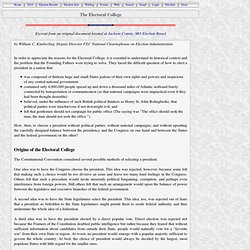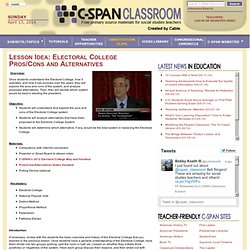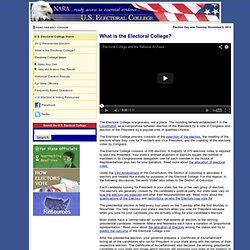

The Electoral College - Origin and History. By William C.

Kimberling, Deputy Director FEC National Clearinghouse on Election Administration In order to appreciate the reasons for the Electoral College, it is essential to understand its historical context and the problem that the Founding Fathers were trying to solve. They faced the difficult question of how to elect a president in a nation that: was composed of thirteen large and small States jealous of their own rights and powers and suspicious of any central national government contained only 4,000,000 people spread up and down a thousand miles of Atlantic seaboard barely connected by transportation or communication (so that national campaigns were impractical even if they had been thought desirable) believed, under the influence of such British political thinkers as Henry St.
Origins of the Electoral College The Constitutional Convention considered several possible methods of selecting a president. One idea was to have the Congress choose the president. Question 1. Question 2. Question 3. Lesson Idea: Electoral College Pros/Cons and Alternatives. Overview: Once students understand the Electoral College, how it operates, and how it has evolved over the years, they will explore the pros and cons of the system, and analyze proposed alternatives.

Then, they will decide which system would be best in electing the president. Objective: Students will understand and explore the pros and cons of the Electoral College system Students will analyze alternatives that have been proposed to the Electoral College System Students will determine which alternative, if any, would be the best system in replacing the Electoral College Materials: Computer(s) with internet connection Projector or Smart Board to stream video C-SPAN’s 2012 Electoral College Map and Handout Pros/Cons/Alternatives Notes Handout Polling Device-optional Vocabulary: Electoral College National Popular Vote District Method Proportional Method Federalism Faithless Elector Introduction: Procedure: In this 9 minute clip, U.S. Additional Articles/Resources (use as needed) B) Decision. Electoral college pros and cons activity.
Electoral College Votes from 2012. Question 1. Question 2. U. S. Electoral College: Add It Up -Electoral College Calculator. Calculator activity. U. S. Electoral College, Official - What is the Electoral College? Election Day was Tuesday, November 6, 2012 The Electoral College is a process, not a place.

The founding fathers established it in the Constitution as a compromise between election of the President by a vote in Congress and election of the President by a popular vote of qualified citizens. The Electoral College process consists of the selection of the electors, the meeting of the electors where they vote for President and Vice President, and the counting of the electoral votes by Congress.
The Electoral College consists of 538 electors. A majority of 270 electoral votes is required to elect the President. Under the 23rd Amendment of the Constitution, the District of Columbia is allocated 3 electors and treated like a state for purposes of the Electoral College. Each candidate running for President in your state has his or her own group of electors. The presidential election is held every four years on the Tuesday after the first Monday in November.
Question 1. Question 2.